Renwang Li
Atomic Norm Minimization-based DoA Estimation for IRS-assisted Sensing Systems
Sep 16, 2024


Abstract:Intelligent reflecting surface (IRS) is expected to play a pivotal role in future wireless sensing networks owing to its potential for high-resolution and high-accuracy sensing. In this work, we investigate a multi-target direction-of-arrival (DoA) estimation problem in a semi-passive IRS-assisted sensing system, where IRS reflecting elements (REs) reflect signals from the base station to targets, and IRS sensing elements (SEs) estimate DoA based on echo signals reflected by the targets. {First of all, instead of solely relying on IRS SEs for DoA estimation as done in the existing literature, this work fully exploits the DoA information embedded in both IRS REs and SEs matrices via the atomic norm minimization (ANM) scheme. Subsequently, the Cram\'er-Rao bound for DoA estimation is derived, revealing an inverse proportionality to $MN^3+NM^3$ under the case of identity covariance matrix of the IRS measurement matrix and a single target, where $M$ and $N$ are the number of IRS SEs and REs, respectively. Finally, extensive numerical results substantiate the superior accuracy and resolution performance of the proposed ANM-based DoA estimation method over representative baselines.
IRS Aided Millimeter-Wave Sensing and Communication: Beam Scanning, Beam Splitting, and Performance Analysis
Jan 27, 2024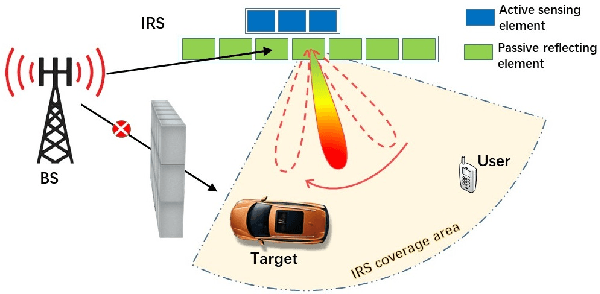
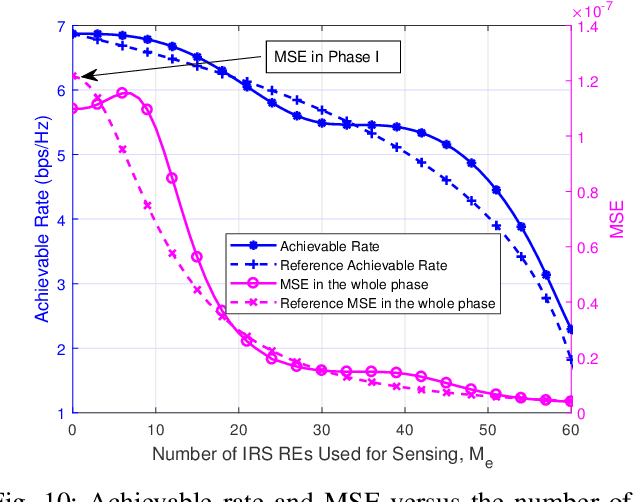
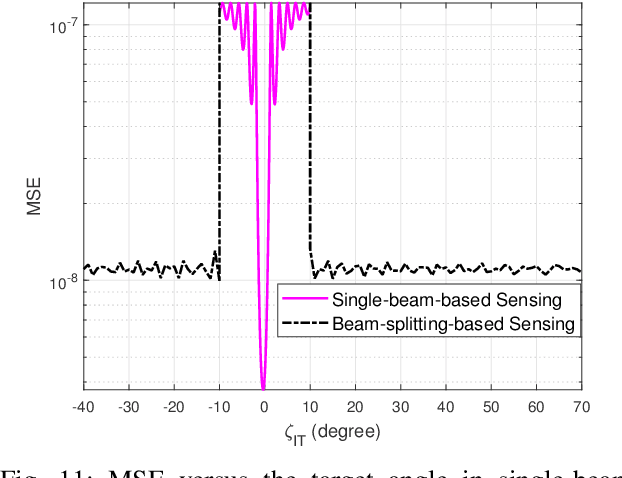
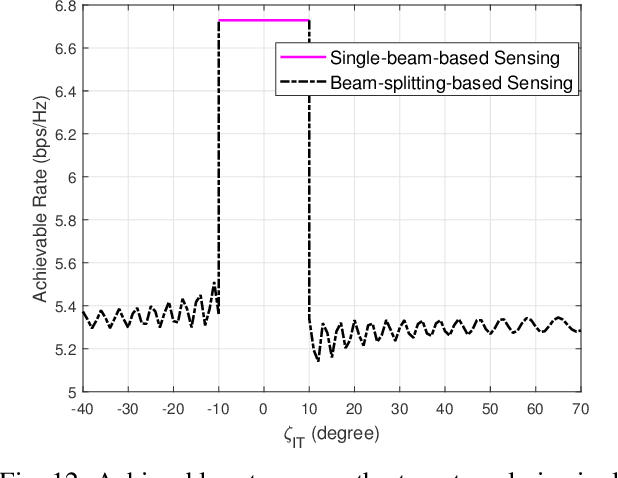
Abstract:Integrated sensing and communication (ISAC) has attracted growing interests for enabling the future 6G wireless networks, due to its capability of sharing spectrum and hardware resources between communication and sensing systems. However, existing works on ISAC usually need to modify the communication protocol to cater for the new sensing performance requirement, which may be difficult to implement in practice. In this paper, we study a new intelligent reflecting surface (IRS) aided millimeter-wave (mmWave) ISAC system by exploiting the distinct beam scanning operation in mmWave communications to achieve efficient sensing at the same time. First, we propose a two-phase ISAC protocol aided by a semi-passive IRS, consisting of beam scanning and data transmission. Specifically, in the beam scanning phase, the IRS finds the optimal beam for reflecting signals from the base station to a communication user via its passive elements. Meanwhile, the IRS directly estimates the angle of a nearby target based on echo signals from the target using its equipped active sensing element. Then, in the data transmission phase, the sensing accuracy is further improved by leveraging the data signals via possible IRS beam splitting. Next, we derive the achievable rate of the communication user as well as the Cram\'er-Rao bound and the approximate mean square error of the target angle estimation Finally, extensive simulation results are provided to verify our analysis as well as the effectiveness of the proposed scheme.
How to Differentiate between Near Field and Far Field: Revisiting the Rayleigh Distance
Sep 23, 2023



Abstract:Future wireless communication systems are likely to adopt extremely large aperture arrays and millimeter-wave/sub-THz frequency bands to achieve higher throughput, lower latency, and higher energy efficiency. Conventional wireless systems predominantly operate in the far field (FF) of the radiation source of signals. As the array size increases and the carrier wavelength shrinks, however, the near field (NF) becomes non-negligible. Since the NF and FF differ in many aspects, it is essential to distinguish their corresponding regions. In this article, we first provide a comprehensive overview of the existing NF-FF boundaries, then introduce a novel NF-FF demarcation method based on effective degrees of freedom (EDoF) of the channel. Since EDoF is intimately related to spectral efficiency, the EDoF-based border is able to characterize key channel performance more accurately, as compared with the classic Rayleigh distance. Furthermore, we analyze the main features of the EDoF-based NF-FF boundary and provide insights into wireless system design.
Beam Scanning for Integrated Sensing and Communication in IRS-aided mmWave Systems
Jul 01, 2023Abstract:This paper investigates an intelligent reflecting surface (IRS) aided millimeter-wave integrated sensing and communication (ISAC) system. Specifically, based on the passive beam scanning in the downlink, the IRS finds the optimal beam for reflecting the signals from the base station to a communication user. Meanwhile, the IRS estimates the angle of a nearby target based on its echo signal received by the sensing elements mounted on the IRS (i.e., semi-passive IRS). We propose an ISAC protocol for achieving the above objective via simultaneous (beam) training and sensing (STAS). Then, we derive the achievable rate of the communication user and the Cramer-Rao bound (CRB) of the angle estimation for the sensing target in closed-form. The achievable rate and CRB exhibit different performance against the duration of beam scanning. Specifically, the average achievable rate initially rises and subsequently declines, while the CRB monotonically decreases. Consequently, the duration of beam scanning should be carefully selected to balance communication and sensing performance. Simulation results have verified our analytical findings and shown that, thanks to the efficient use of downlink beam scanning signal for simultaneous communication and target sensing, the STAS protocol outperforms the benchmark protocol with orthogonal beam training and sensing.
Applicable Regions of Spherical and Plane Wave Models for Extremely Large-Scale Array Communications
Jan 15, 2023



Abstract:Extremely large-scale array (XL-array) communications can significantly improve the spectral efficiency and spatial resolution, and has great potential in next-generation mobile communication networks. A crucial problem in XL-array communications is to determine the boundary of applicable regions of the plane wave model (PWM) and spherical wave model (SWM). In this paper, we propose new PWM/SWM demarcations for XL-arrays from the viewpoint of channel gain and rank. Four sets of results are derived for four different array setups. First, an equi-power line is derived for a point-to-uniform linear array (ULA) scenario, where an inflection point is found at $\pm \frac{\pi}{6}$ central incident angles. Second, an equi-power surface is derived for a point-to-uniform planar array (UPA) scenario, and it is proved that $\cos^2(\phi) \cos^2(\varphi)=\frac{1}{2}$ is a dividing curve, where $\phi$ and $\varphi$ denote the elevation and azimuth angles, respectively. Third, an accurate and explicit expression of the equi-rank surface is obtained for a ULA-to-ULA scenario. Finally, an approximated expression of the equi-rank surface is obtained for a ULA-to-UPA scenario. With the obtained closed-form expressions, the equi-rank surface for any antenna structure and any angle can be well estimated. Furthermore, the effect of scatterers is also investigated, from which some insights are drawn.
Hybrid Spherical- and Planar-Wave Channel Modeling and Estimation for Terahertz Integrated UM-MIMO and IRS Systems
May 26, 2022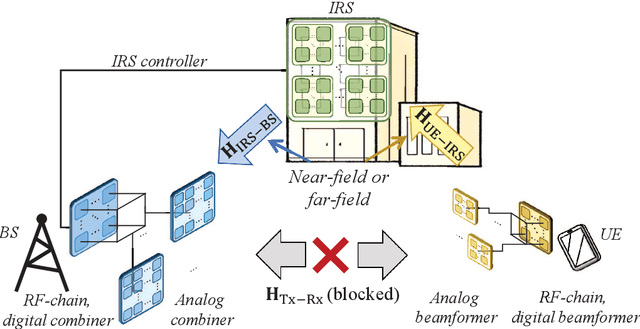


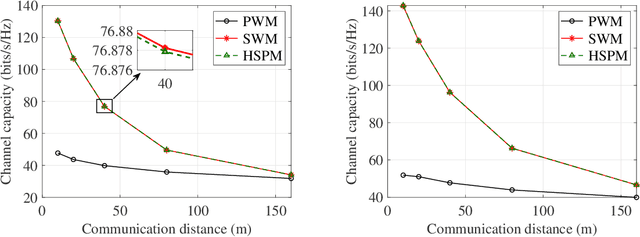
Abstract:Integrated ultra-massive multiple-input multiple-output (UM-MIMO) and intelligent reflecting surface (IRS) systems are promising for 6G and beyond Terahertz (0.1-10 THz) communications, to effectively bypass the barriers of limited coverage and line-of-sight blockage. However, excessive dimensions of UM-MIMO and IRS enlarge the near-field region, while strong THz channel sparsity in far-field is detrimental to spatial multiplexing. Moreover, channel estimation (CE) requires recovering the large-scale channel from severely compressed observations due to limited RF-chains. To tackle these challenges, a hybrid spherical- and planar-wave channel model (HSPM) is developed for the cascaded channel of the integrated system. The spatial multiplexing gains under near-field and far-field regions are analyzed, which are found to be limited by the segmented channel with a lower rank. Furthermore, a compressive sensing-based CE framework is developed, including a sparse channel representation method, a separate-side estimation (SSE) and a dictionary-shrinkage estimation (DSE) algorithms. Numerical results verify the effectiveness of the HSPM, the capacity of which is only $5\times10^{-4}$ bits/s/Hz deviated from that obtained by the ground-truth spherical-wave-model, with 256 elements. While the SSE achieves improved accuracy for CE than benchmark algorithms, the DSE is more attractive in noisy environments, with 0.8 dB lower normalized-mean-square-error than SSE.
 Add to Chrome
Add to Chrome Add to Firefox
Add to Firefox Add to Edge
Add to Edge